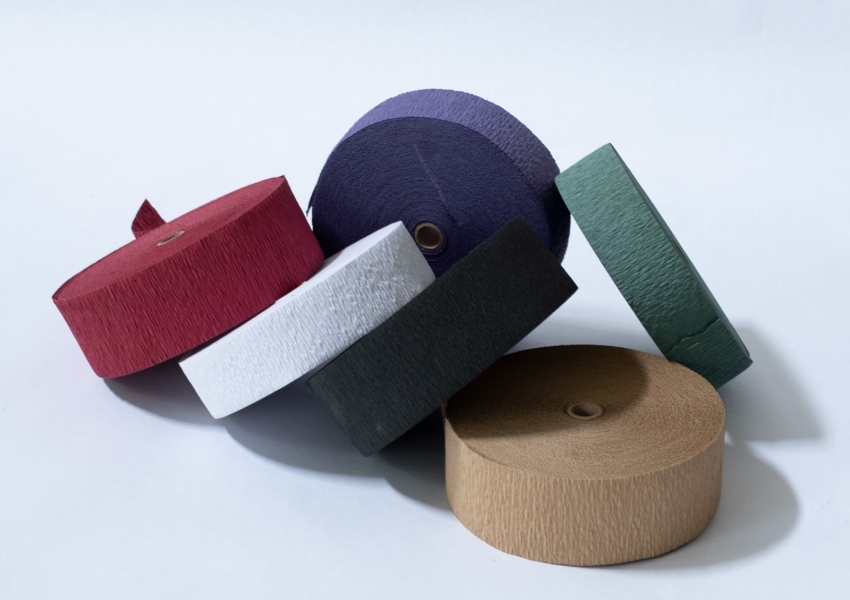What is Crepe Paper?
Crepe paper is a flexible and durable material that is made by pleating base paper. Its crinkled texture allows it to stretch and easily adapt to different types of products, especially those with irregular shapes. This characteristic makes it ideal for sustainable packaging in industrial environments, where the goal is to protect products while reducing waste and environmental impact.
Properties of Crepe Paper for Sustainable Packaging
Crepe paper has several qualities that make it stand out as a packaging material:
- Elasticity and strength: Despite its wrinkled structure, crepe paper is remarkably strong. Its ability to stretch without tearing makes it ideal for protecting products during transportation, thus contributing to sustainable packaging.
- Natural cushioning: Thanks to its folds, crepe paper can absorb shocks and vibrations, making it an excellent cushion for fragile products.
- Adaptability to various shapes: One of the great advantages of crepe paper is its ability to effectively wrap products, even those with unconventional shapes, which allows for more efficient use of the material and reduces the need for additional materials.
- Recyclability: In the context of sustainable packaging, crepe paper is an excellent option. It is fully recyclable and biodegradable, which reduces the amount of waste generated compared to plastics or other non-recyclable materials.
Applications of Crepe Paper in Industrial Packaging
Crepe paper has gained traction as a sustainable packaging material in various industries, such as:
- Electronics: Electronic components, due to their delicacy, require effective protection. Crepe paper is used to wrap these components, providing cushioning and ensuring their integrity during transport.
- Automotive: Mechanical and metal parts can be easily damaged if not well-protected. Crepe paper is used to prevent these parts from rubbing against each other or being impacted, contributing to sustainable packaging in the automotive industry.
- Glass and ceramics: Fragile products, such as bottles, tableware, or ceramic pieces, require packaging that protects them from bumps and drops. Crepe paper, with its shock-absorbing properties, is ideal for this type of product.
- Food and agricultural products: In the agricultural sector, crepe paper is used to wrap fresh products, such as fruits and vegetables, contributing to sustainable packaging that also allows the products to breathe, preventing moisture buildup.
Advantages of Crepe Paper for Sustainable Packaging
The use of crepe paper as an industrial packaging material has several advantages in terms of sustainability and efficiency:
- Lower environmental impact: Being recyclable and biodegradable, crepe paper significantly reduces the carbon footprint of companies that use it in their packaging processes. This is crucial in an environment where more and more companies are looking for ways to reduce their environmental impact.
- Cost savings: In addition to being more eco-friendly, crepe paper is a more economical option than other packaging materials. Its ability to adapt to different products and needs reduces the amount of material required, resulting in long-term savings.
- Waste reduction: As companies focus on sustainable packaging, crepe paper becomes an effective solution to minimize waste generated during the packaging process.
- Ease of use: Crepe paper is easy to handle and apply in production lines, speeding up the packaging process without the
need to invest in expensive or complex machinery.
Challenges and Considerations in the Use of Crepe Paper
Despite its numerous advantages, using crepe paper as a packaging material also presents some challenges:
- Moisture resistance: Although crepe paper can be treated with special coatings to improve its moisture resistance, it is not waterproof in its natural state. For products that require additional protection against moisture, it is necessary to combine crepe paper with other materials or treatments, which can increase costs.
- Long-term durability: Crepe paper is suitable for short and medium-term applications, but in some cases, it may not be as durable as other industrial packaging materials like plastic or corrugated cardboard. However, in contexts where sustainable packaging is a priority, companies are often willing to accept this trade-off.
Crepe Paper and Sustainability: A Promising Future
Sustainability has become a fundamental pillar in most industries, and the packaging sector is no exception. More and more companies are adopting sustainable packaging solutions, seeking materials that not only meet protection requirements but also reduce environmental impact.
In this regard, crepe paper is positioned as a key material in the future of industrial packaging. Its ability to adapt to different products, its recyclable and biodegradable nature, and its efficiency in resource use make it an ideal option for companies committed to sustainability.
Moreover, with the growing demand for alternatives to plastic, the use of crepe paper is expected to continue growing. Companies are investing in technologies that further enhance the properties of crepe paper, making it even more durable and adaptable to a wider range of products.
Conclusion
Crepe paper has proven to be an effective solution for sustainable packaging in the industrial sector. Its properties of flexibility, strength, and recyclability make it an ideal material for protecting products of various sizes and shapes. As sustainability becomes a priority for companies, crepe paper plays a fundamental role in the transition to a more eco-friendly future in industrial packaging.




